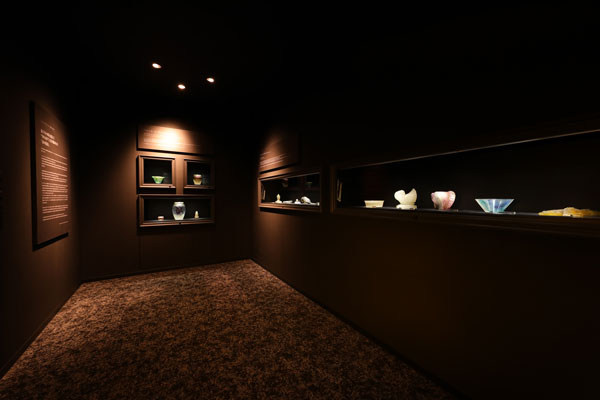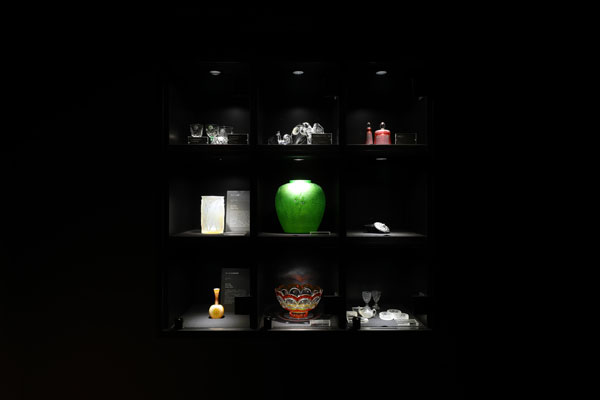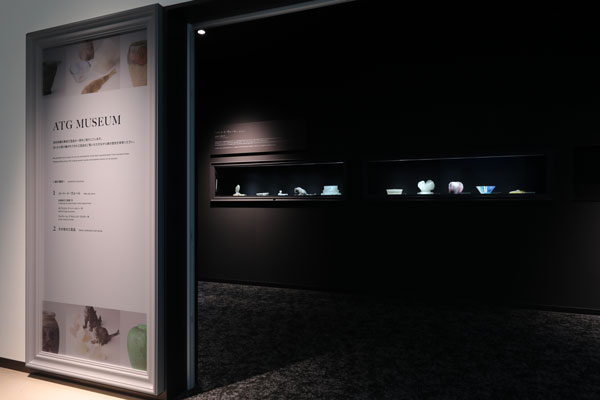
We present you to part of our art works which have been passed down from ancient times.
Please kindly enjoy the unique quaint works and feel the history of its beauty.

Pâte de verre
A Lost Technique from Thousands of Years Ago that IWAKI Has Recreated
At ATG MUSEUM, we are pleased to introduce some of the traditional art and craft pieces passed down within Iwaki Glass Manufacturing (today AGC TECHNO GLASS Co., Ltd.) from long ago, with a particular focus on works of pâte de verre produced by the Iwaki Glass Crafts Department.
Pâte de verre (“paste of glass” in English) is a kind of glass art which is said to have been named after either its appearance or production method.
It is a type of glass casting in which clay or plaster is used to make a mold, and this is then used to form the basis for a mold made from fireproof plaster. This is filled with a mixture of various colored glass powders and glue, and fired in a kiln. After the mold has been slowly cooled down over a long period of time, the glass is removed and polished.
A feature of this glass casting is that it is possible to freely mix the fineness of the glass particles, different colors, and densities, etc., to match a desired outcome. These colors permeate into the interior and become even richer which gives it visual characteristics that can’t be achieved with normal glass products.
It is possible to create artworks of high artistic value by making full use of a rich array of colors and having the freedom to shape art as one wishes. In addition, it is said that the resulting artwork produced using this technique is very valuable and represents the pinnacle of glass craftsmanship because it is technically extremely delicate and involves complex processes.
The origin of pâte de verre dates back to the ancient past when Mesopotamian civilizations were flourishing. The technique of firing a mold filled with glass powder or fragments was the primary production method for glass until the era of the Roman Empire when blown glass was invented, but it disappeared with the collapse of the Roman Empire, and so it is known as a lost technique.
About 2,000 years later, Henri Cros (1840-1907), a French sculptor and painter, became fascinated by the manufacturing techniques of Roman artworks that were at the Louvre Museum, and after a lot of research over a number of years he succeeded in creating his own artworks. It is said that this was the beginning of modern pâte de verre.
Pâte de verre gained attention together with Art Nouveau, which was the trend at the time, and many artists were inspired by the art of Henry Cros and tried to develop their own versions. This led to the appearance of great artists such as François Décorchemont, Victor Amalric Walter, and Gabriel Argy-Rousseau, who established a golden age for French pâte de verre. Consequently, a large number of artworks were created using the lost technique.
In Japan, Saburosuke Okada (1869-1939), a Western-style painter, and Ichiga Numata (1873-1954), a ceramic sculptor, who both had studied in France during the Art Nouveau era, wanted to recreate this technique after they returned to Japan, and so they asked the Iwaki Glass Engineering Department for help. The Iwaki Glass Engineering Department succeeded in creating the first artwork in Japan using this unique technique after years of painstaking research. It is said that this achievement opened a new chapter in the glass industry.
Today, this technique is almost lost to us, but the artworks that were made at the time still welcome visitors with a peaceful radiance.
The artworks on display here carry the thoughts of artists from past eras, and without doubt one can feel the history of their beauty while enjoying their rich colors and glossy brilliance.
Source: 2000 Years of Japanese Glass: From the Yayoi Period to the Present Day (Suntory Museum of Art) and A HISTORY OF GLASS IN JAPAN (Glass Manufacturers' Association of Japan)


